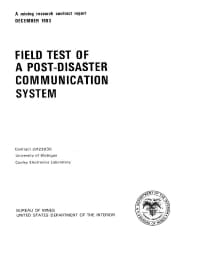Mining Publication: Field Test of a Post-Disaster Communication System
Original creation date: December 1983
Authors: MP Ristenbatt, EK Holland-Moritz, K Metzger
NIOSHTIC2 Number: 10004190
University of Michigan. U.S. Department of the Interior, Bureau of Mines, Contract No. J0123030. NTIS: PB/85-109270, OFR 182-84, 1983; :1-51
A new postdisaster communication and location system using through-the-earth electromagnetic wave propagation was tested at the Bureau of Mines Lake Lynn Experimental Mine. Successful detection of the signal, estimated to be at a signal-to-noise ratio (SNR) of -30 dB, was accomplished using a coherent integration time of 4.46 Min. The transmitted waveform consisted of a repeating pseudo-noise maximal length sequence phase modulating a 1,950-Hz carrier. The receiver used a sliding-window matched filter, optimal for signal known exactly except for phase and starting time, implemented via a special purpose processor. Parallel processing permits adaptive signaling where the detection (integration) time is determined by the actual input SNR encountered. The field test demonstrates a trapped miner detection system that is about 36 dB more sensitive than the current pulsed system. The increased sensitivity permits some desired combination of increased range, shorter detection time, and reduced transmitter power or antenna size.

NIOSHTIC2 Number: 10004190
University of Michigan. U.S. Department of the Interior, Bureau of Mines, Contract No. J0123030. NTIS: PB/85-109270, OFR 182-84, 1983; :1-51
- Communication Systems Research At Bruceton Safety Research Mine
- Experience with an Integrated, Computer-Controlled Communications and Monitoring System at the Robena Mine
- Preliminary Performance Predictions For Electromagnetic Through-The-Earth Mine Communications: A Collection of Working Memoranda
- Propagation of EM Signals in Underground Mines
- Research and Development Contract for Coal Mine Communication System: Volume 3 - Theoretical Data Base
- Technology News 551 - Through-the-Earth, Post-Accident Communications - an Emerging Technology - TN-No. 551
- Theoretical Noise and Propagation Models for Through-the-earth Communication
- Through-The-Earth Wireless Real-Time Two-Way Voice Communications
- U.S. Bureau of Mines New Developments in Mine Communications
- Ultra-Low Frequency Through-the-Earth Communication Technology